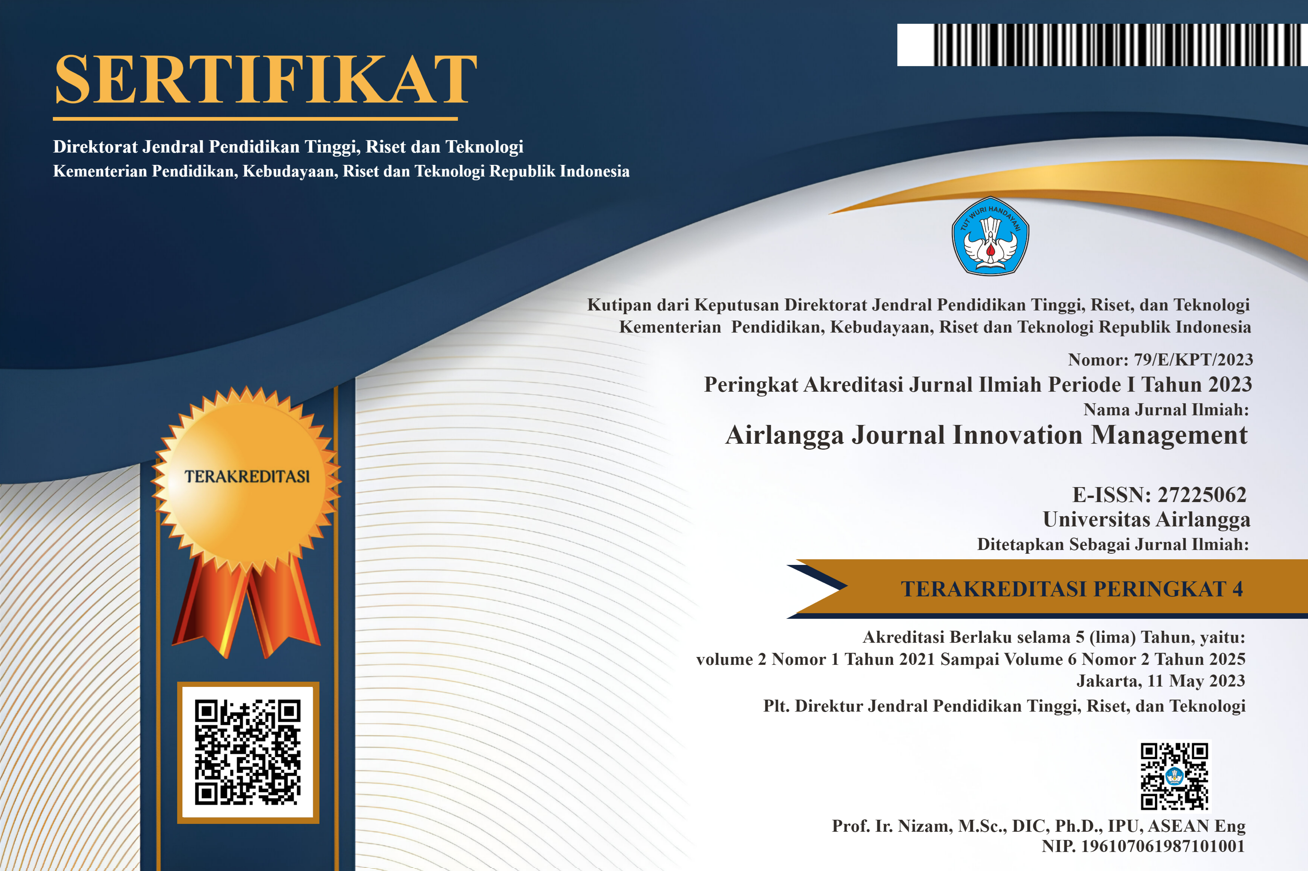Integration of Kansei Engineering and Design Thinking for Mobile UI/UX Development in Manufacturing
The increasing digitalization of the manufacturing industry has encouraged companies to develop mobile applications that can optimize operational and administrative processes. However, limited studies have specifically addressed integrating emotional and functional aspects in designing user interfaces (UI) and user experiences (UX) for mobile applications in the manufacturing context. This study aims to develop a mobile application UI/UX design that aligns with users' emotional preferences and usability needs across three departments: logistics, maintenance, and production. The research integrates the Kansei Engineering method and Design Thinking framework through five stages: empathize, define, ideate, prototype, and test. In the empathize stage, in-depth interviews and empathy mapping were conducted to capture user needs, utilizing a qualitative approach to gain deep insights into users’ emotional preferences. The ideate phase utilized Kansei Engineering Type I and factor analysis to classify emotional preferences (Kansei words) into two design modes: professional and simple. Quantitative analysis using Partial Least Squares (PLS) Regression was applied to map emotional preferences with design elements. Prototypes were developed based on these mappings and evaluated through usability testing, using metrics such as completion rate, time on task, error rate, and PSSUQ (Post-Study System Usability Questionnaire). The results show that the professional concept design performed better in usability and user satisfaction. This research provides a practical framework for integrating emotional and functional needs into UI/UX design, combining qualitative and quantitative methods, and offers insights for future digital application development in the manufacturing industry.
Adirestuty, F., Ratnasart, R. T., Wardhana, A. K., Miraj, D. A., & Battour, M. (2025). Gastronomy of religious tourism: Overview and future research agenda. Geo Journal of Tourism and Geosites, 58(1), 188–199.
Arifin, S., Zaki, I., Ryandono, M. N. H., Zulaikha, S., Hendratmi, A., Rani, L. N., Bayuny, A. F. R., & Wijayanti, I. (2024). Penguatan Kesejahteraan Masyarakat melalui Pelatihan Ternak, Manajemen Keuangan, dan Koperasi Syariah. Jurnal Ilmiah Pengabdian Dan Inovasi, 3(2), 103–124.
BCG. (2022). BCG-WEF Project: Unlocking Value in Manufacturing Through Data. Https://Www.Bcg.Com/.
Fang, W., Deng, F., & Li, Z. (2025). Promote or inhibit? Digital manufacturing and urban green transformation - Empirical evidence from China. Sustainable Futures, 9(April), 100686. https://doi.org/10.1016/j.sftr.2025.100686
Fauzi, Q., Ulfah, U., & Wijayanti, I. (2024). Ethical challenges in transportation: A study on the implementation of Islamic business values. Al-Uqud: Journal of Islamic Economics, 8(2).
Febriyanti, A. R., Ratnasari, R. T., & Wardhana, A. K. (2022). The Effect of Economic Growth, Agricultural Land, and Trade Openness Moderated By Population Density on Deforestation in OIC Countries. Quantitative Economics and Management Studies, 3(2).
Gröger, C., Silcher, S., Westkämper, E., & Mitschang, B. (2013). Leveraging apps in manufacturing. A framework for app technology in the enterprise. Procedia CIRP, 7, 664–669. https://doi.org/10.1016/j.procir.2013.06.050
Hadiana, A. (2017). Interface modeling for mobile learning using kansei engineering and analytical hierarchy process. Proceedings - 2017 International Conference on Computer, Control, Informatics and Its Applications: Emerging Trends In Computational Science and Engineering, IC3INA 2017, 2018-Janua, 153–157. https://doi.org/10.1109/IC3INA.2017.8251758
Hadiana, A. (2018). Designing Interface of Mobile Parental Information System based on Users’ Perception Using Kansei Engingeering. Journal of Data Science and Its Applications, 1(1), 10–19. https://doi.org/10.21108/jdsa.2018.1.7
Hanington, B., & Martin, B. (2019). Universal methods of design expanded and revised: 125 Ways to research complex problems, develop innovative ideas, and design effective solutions. Rockport publishers.
Hartono, M. (2020). The modified Kansei Engineering-based application for sustainable service design. International Journal of Industrial Ergonomics, 79(July), 102985. https://doi.org/10.1016/j.ergon.2020.102985
Hartono, M., Herdiana, W., Sujatmiko, G., Annora, C., Parung, P., & Jaya, B. K. (2025). Integration of Kansei Engineering and Nudge Based Design Thinking for Patient Comfort in Healthcare Services. 27(1).
Lewis, J. R., & Sauro, J. (2021). Usability and user experience: Design and evaluation. Handbook of Human Factors and Ergonomics, 972–1015.
Liedtka, J., & Ogilvie, T. (2011). Designing for growth: A design thinking tool kit for managers. Columbia University Press.
Liu, Y., Wang, Y., & Ming, Z. (2025). Synergy degree measurement of traditional manufacturing and green industry driven by digital economy in Yangtze River Delta region. Data Science and Informetrics. https://doi.org/10.1016/j.dsim.2025.02.001
Mendo, A. Y., Singh, S. K., Yantu, I., Hinelo, R., Bokingo, A. H., Dungga, E. F., Juanna, A., Wardhana, A. K., Niroula, B., & Win, T. (2023). Entrepreneurial leadership and global management of COVID-19: A bibliometric study. F1000Research, 12(31), 31.
Meng, T., Li, Q., He, C., & Dong, Z. (2025). Research on the configuration path of manufacturing enterprises’ digital servitization transformation. International Review of Economics and Finance, 98(December 2024). https://doi.org/10.1016/j.iref.2025.103952
Mohd Lokman, A. (2010). Design & emotion: The kansei engineering methodology. Malaysian Journal of Computing (MJOC), 1(1), 1–14.
Muhaimin, H., Herachwati, N., Hadi, C., Wihara, D. S., & Wardhana, A. K. (2023). Entrepreneurship Leadership: Fostering An Entrepreneurial Spirit In Students During Pandemic Covid-19 (Case Study In Tebuireng Boarding School East Java). Journal of Namibian Studies: History Politics Culture, 33, 5597–5610.
Nagamachi, M. (2011). Kansei/affective engineering and history of Kansei/affective engineering in the world. Kansei/Affective Engineering, 13, 1–12.
Noori, F., Zadeh, S. S., & Kazemifard, M. (2015). 2015 Sixth International Conference of Cognitive Science (ICCS).
Nugroho, I. M. ruf, Hadiana, A., & Singasatia, D. (2019). Design of Wastu Mobile Interface Using Kansei Engineering. Proceedings of 2019 4th International Conference on Informatics and Computing, ICIC 2019. https://doi.org/10.1109/ICIC47613.2019.8985955
Pratama, Y. B., Wardhana, A. K., & Nugroho, P. A. (2020). HUBUNGAN ANTARA ARTIKEL MENGENAI GAME DAN TEKNOLOGI INFORMASI PADA SCOPUS: STUDI BIBLIOGRAFI. VISI PUSTAKA: Buletin Jaringan Informasi Antar Perpustakaan, 22(1).
Qosim, N., Ratnasari, R. T., Wardhana, A. K., Fauziana, H., & Barkah, T. T. (2023). Eight Years of Research Related to the Green Sukuk in the Global Stock Exchange Market to Support the Implementation of SDG: A Bibliometric Review. Journal of Islamic Economic and Business Research, 3(2), 161–180.
Riduwan, R., & Wardhana, A. K. (2022). Effect of industrial digitalization on total halal meat production in Java. Journal of Halal Product and Research, 5(1), 24–31.
Rinawiyanti, E. D., Surjani, R. M., Hartono, M., Permatasari, E. P., & Chrisma, A. C. V. (2025). Mixed Method Usability Testing for User Experience and User Interface of AI-Based Supermarket Applications. Journal of Applied Data Sciences, 6(1), 483–495. https://doi.org/10.47738/jads.v6i1.453
Ristias, A. A., Amin, M. S., & Agussalim, A. (2023). UI/UX design on Digilearn application with the iterative design thinking methodology. Information Technology International Journal, 1(1).
Rohwana, U., & Irawan, M. I. (2024). Developing Start-Up That Creates a Platform of School-to-Parent Reports : A Design Thinking Approach. 05(02), 321–334.
Ryandono, M. N. H., Mawardi, I., Rani, L. N., Widiastuti, T., Ratnasari, R. T., & Wardhana, A. K. (2022). Trends of research topics related to Halal meat as a commodity between Scopus and Web of Science: A systematic review. F1000Research, 11(1562), 1562.
Santoso, T. B., & Kusuma, A. (2023). The Development of the Usage of Blockchain for Waqf and Zakat Globally: A Bibliometric Study. International Journal of Mechanical Computational and Manufacturing Research, 13(3), 83–91.
Shakoor, A. (2024). The Impact of Emotional Design in UX The Impact of Emotional Design in UX. February, 0–8.
Suprayogi, N., Fianto, B. A., Febriyanti, A. R., Sukmaningrum, P. S., Filianti, D., & Wijayanti, I. (2025). PEMBERDAYAAN MASYARAKAT PESISIR DI DESA KWANYAR BARAT, BANGKALAN, MADURA: PERSPEKTIF KEBERLANJUTAN LINGKUNGAN, KESEHATAN, DAN EKONOMI DIGITAL. Jurnal Terapan Abdimas, 10(1), 1–10.
Suratno, B., & Shafira, J. (2022). Development of user interface/user experience using design thinking approach for GMS service company. Journal of Information Systems and Informatics, 4(2), 469–494.
Susanto, A. A., Suprayitno, A., Zulaikha, S., & Wardhana, A. K. (2025). How Islamic Leadership and Islamic Worldview Play a Role in Restoring a Country’s Economic Glory: Blibliometrical Analysis. Jurnal Transformatif (Islamic Studies), 9(1), 40–56.
Sutcliffe, A. (2017). Designing user interfaces in emotionally-sensitive applications. Human-Computer Interaction--INTERACT 2017: 16th IFIP TC 13 International Conference, Mumbai, India, September 25--29, 2017, Proceedings, Part III 16, 404–422.
Suzianti, A., & Arrafah, G. (2019). User interface redesign of dental clinic ERP system using design thinking: A case study. ACM International Conference Proceeding Series, September 2019, 193–197. https://doi.org/10.1145/3364335.3364369
Suzianti, A., Irianto, J. B., & Fathia, S. N. (2024). Designing a local tour guide application using design thinking approach. AIP Conference Proceedings, 2710(1). https://doi.org/10.1063/5.0145175
Suzianti, A., Wulandari, A. D., Yusuf, A. H., Belahakki, A., & Monika, F. (2020). Design Thinking Approach for Mobile Application Design of Disaster Mitigation Management. ACM International Conference Proceeding Series, January, 29–33. https://doi.org/10.1145/3379310.3379324
Tian, M., Chen, Y., Tian, G., Huang, W., & Hu, C. (2023). The role of digital transformation practices in the operations improvement in manufacturing firms: A practice-based view. International Journal of Production Economics, 262, 108929.
Tschimmel, K. (2012). Design Thinking as an effective Toolkit for Innovation. ISPIM Conference Proceedings, 1.
Turumugon, P., & Baharum, A. (2018). Identifying a user interface web design standard for higher learning institutions using kansei engineering. Indonesian Journal of Electrical Engineering and Computer Science, 11(1), 90–97. https://doi.org/10.11591/ijeecs.v11.i1.pp90-97
VisualSP. (2024). Digital Transformation in Manufacturing. Visualsp.Com.
Yudha, A. T. R. C., Huda, N., Maksum, M., Sherawali, S., & Wijayanti, I. (2024). The Moderating Effect of Religiosity on Fashion Uniqueness and Consciousness in Halal Fashion Purchase. Indonesian Journal of Halal Research, 6(2), 71–84.
Yudhanto, Y., Pratisto, E. H., Purnomo, F. A., Hidayat, T. N., Haqimi, N. A., & Ardhi, O. D. W. (2024). Design and Development Museum Ticketing System (MTS) with Design Thinking Method. Procedia Computer Science, 234(2023), 1212–1219. https://doi.org/10.1016/j.procs.2024.03.117
Zhang, Y., Ma, X., Pang, J., Xing, H., & Wang, J. (2023). The impact of digital transformation of manufacturing on corporate performance—The mediating effect of business model innovation and the moderating effect of innovation capability. Research in International Business and Finance, 64, 101890.
Copyright (c) 2025 Airlangga Journal of Innovation Management

This work is licensed under a Creative Commons Attribution-NonCommercial-ShareAlike 4.0 International License.
- The journal allows authors to hold copyright without restrictions and retain publication rights without restrictions. The author retains the copyright and grants the first publication rights to the journal, with his work simultaneously licensed under the Creative Commons Attribution-NonCommercial-ShareAlike 4.0 International License (CC BY-NC-SA). This license allows others to share the work with acknowledgment of authorship and initial publication in this journal, provided that the work is not used for commercial purposes and that any derivative works must use the same license.
- Authors may enter into additional contractual agreements for non-exclusive distribution of the journal publication version (e.g., uploading it to an institutional repository or publishing it in book form), while still including acknowledgment of the initial publication in this journal.
- Authors are allowed and encouraged to upload their work online (e.g., in an institutional repository or personal website) before and during the submission process. This can support productive scientific exchanges as well as increase citations to published works.

AJIM by UNAIR is licensed under a Creative Commons Attribution-NonCommercial-ShareAlike 4.0 International License.





















